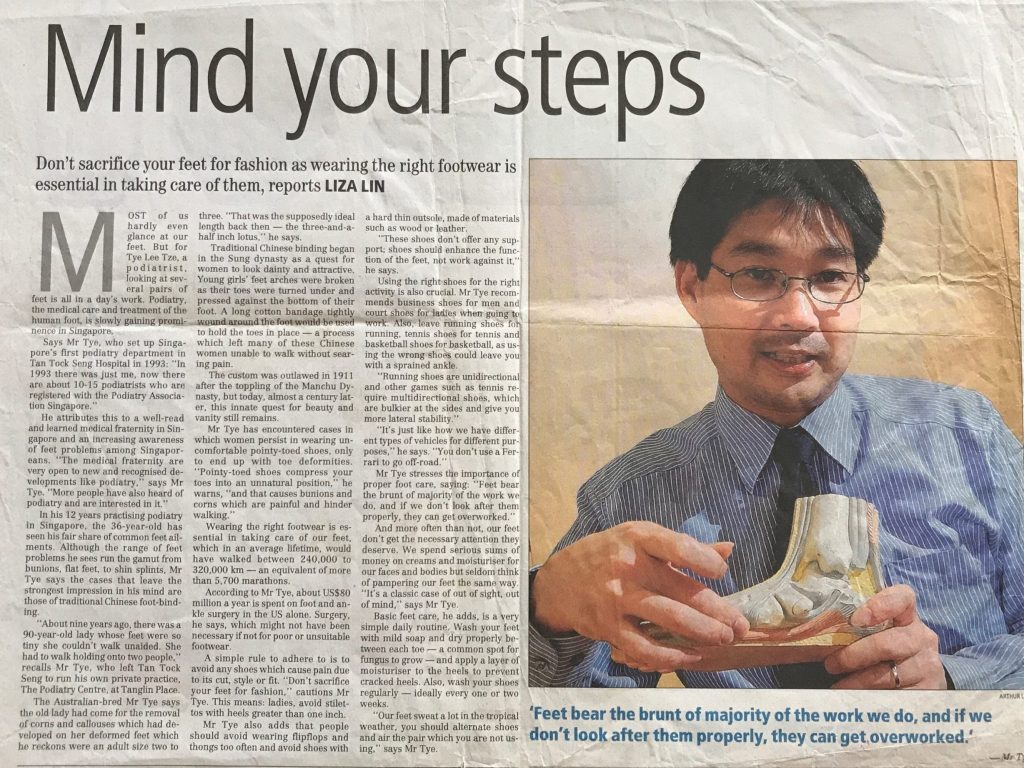Don’t sacrifice your feet for fashion as wearing the right footwear is essential in taking care of them, reports LIZA LIN.
Most of us hardly even glance at our feet. But for Tye Lee Tze, a podiatrist, looking at several pairs of feet is all in a day’s work. Podiatry, the medical care and treatment of the human foot, is slowly gaining prominence in Singapore.
Says Mr Tye, who set up Singapore’s first podiatry department in Tan Tock Seng Hospital in 1993: “In 1993 there was just me, now there are about 10-15 podiatrists who are registered with the Podiatry Association Singapore.”
He attributes this to a well-read and learned medical fraternity in Singapore and an increasing awareness of feet problems among Singaporeans. “The medical fraternity are very open to new and recognised developments like podiatry,” says Mr Tye. “More people have also heard of podiatry and are interested in it.”
In his 12 years practising podiatry in Singapore, the 36-year-old has seen his fair share of common feet ailments. Although the range of feet problems he sees run the gamut from bunions, flat feet, to shin splints, Mr Tye says the cases that leave the strongest impression in his mind are those of traditional Chinese foot-binding.
“About nine years ago, there was a 90-year-old lady whose feet were so tiny she couldn’t walk unaided. She had to walk holding onto two people,” recalls Mr Tye, who left Tan Tock Seng to run his own private practice, The Podiatry Centre, at Tanglin Place.
The Australian-bred Mr Tye says the old lady had come for the removal of corns and callouses which had developed on her deformed feet which he reckons were an adult size two to three. “That was the supposedly ideal length back then — the three-and-a-half inch lotus,” he says.
Traditional Chinese binding began in the Sung dynasty as a quest for women to look dainty and attractive. Young girls’ feet arches were broken as their toes were turned under and pressed against the bottom of their foot. A long cotton bandage tightly wound around the foot would be used to hold the toes in place — a process which left many of these Chinese women unable to walk without searing pain.
The custom was outlawed in 1911 after the toppling of the Manchu Dynasty, but today, almost a century later, this innate quest for beauty and vanity still remains.
Mr Tye has encountered cases in which women persist in wearing un-comfortable pointy-toed shoes, only to end up with toe deformities. “Pointy-toed shoes compress your toes into an unnatural position,” he warns, “and that causes bunions and corns which are painful and hinder walking.”
Wearing the right footwear is essential in taking care of our feet, which in an average lifetime, would have walked between 240,000 to 320,000 km — an equivalent of more than 5,700 marathons.
According to Mr Tye, about US$80 million a year is spent on foot and ankle surgery in the US alone. Surgery, he says, which might not have been necessary if not for poor or unsuitable footwear.
A simple rule to adhere to is to avoid any shoes which cause pain due to its cut, style or fit. “Don’t sacrifice your feet for fashion,” cautions Mr Tye. This means: ladies, avoid stilettos with heels greater than one inch.
Mr Tye also adds that people should avoid wearing flipflops and thongs too often and avoid shoes with a hard thin outsole, made of materials such as wood or leather.
“These shoes don’t offer any sup-port; shoes should enhance the function of the feet, not work against he says.
Using the right shoes for the right! activity is also crucial. Mr Tye recommends business shoes for men and’ court shoes for ladies when going to work. Also, leave running shots fo running, tennis shoes for tennis an basketball shoes for basketball, as using the wrong shoes could leave you with a sprained ankle.
“Running shoes are unidirectional and other games such as tennis re-quire multidirectional shoes, which are bulkier at the sides and give you more lateral stability.” “It’s just like how we have different types of vehicles for different purposes,” he says. “You don’t use a Ferrari to go off-road.”
Mr Tye stresses the importance of proper foot care, saying: “Feet bear the brunt of majority of the work we do, and if we don’t look after them properly, they can get overworked.”
And more often than not, our feet don’t get the necessary attention they deserve. We spend serious sums of money on creams and moisturiser for our faces and bodies but seldom think – of pampering our feet the same way. “It’s a classic case of out of sight, out, of mind,” says Mr Tye.
Basic feet care, he adds, is a very simple daily routine. Wash your feet with mild soap and dry properly be-tween each toe — a common spot for fungus to grow — and apply a layer of moisturiser to the heels to prevent cracked heels. Also, wash your shoes regularly — ideally every one or two weeks. “Our feet sweat a lot in the tropical weather, you should alternate shoes and air the pair which you are not using,” says Mr Tye.
Caption: ‘Feet bear the brunt of majority of the work we do, and if we don’t look after them properly, they can get overworked.’ – Mr Tye
By Liza Lin. Originally posted in The Business Times, May 28-29, 2005.

